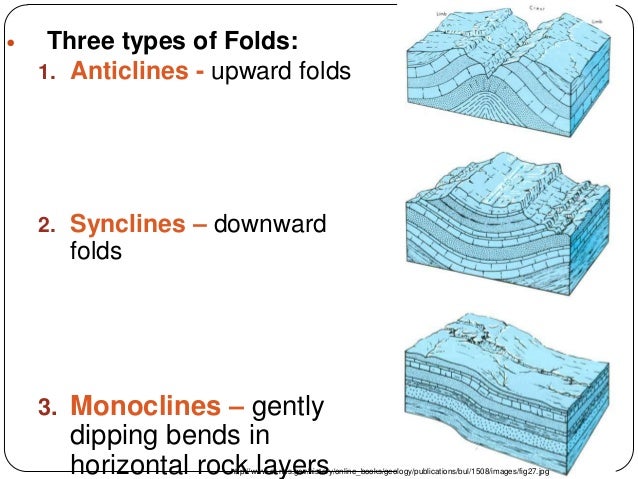Definition of Folds:
1.Bends or wave like features in layered rocks due to compressive stress.
2.Folds form from curving,bending, and buckling of originally planar rock layers(e.g beds, foliation) through ductile deformation.
3.folds are wave like structures that are produced by deformation of bedding,foliation or other planar surfaces in the rocks
Explanation:
Along convergent plate boundaries, flat-lying sedimentary strata, tabular intrusions, and volcanic
rocks are often bent into a series of wavelike undulations called folds. Folds in sedimentary strata
are similar to that would form if you were to hold the ends of a sheet of paper on a flat surface and then push them together. In nature, folds come in a wide range of sizes and configurations. Some folds are vast flexures in which strata hundreds of meters thick have been slightly
warped. Others are very tight microscopic structures found in metamorphic rocks. Size differences
notwithstanding, most folds result from compressional stresses that result in a shortening and
thickening of the crust.
rocks are often bent into a series of wavelike undulations called folds. Folds in sedimentary strata
are similar to that would form if you were to hold the ends of a sheet of paper on a flat surface and then push them together. In nature, folds come in a wide range of sizes and configurations. Some folds are vast flexures in which strata hundreds of meters thick have been slightly
warped. Others are very tight microscopic structures found in metamorphic rocks. Size differences
notwithstanding, most folds result from compressional stresses that result in a shortening and
thickening of the crust.
To aid our understanding of folds and folding, it isimportant to become familiar with the terminology used
to name the parts of a fold.
to name the parts of a fold.
Folds are geologic structuresconsisting of stacks of originally horizontal surfaces, such as sedimentary strata, that have been bent as a result ofpermanent deformation. Each layer is bent around animaginary axis called a hinge line, or simply a hinge.
Terminology of folds:
1.Limbs:Portion of Fold between two consective hing points.
2.Fold axis or hinge line: A line connecting points of maximum curvature along a fold.
3.Axial Plane: An imaginary surface that divides a fold symmetrically.

Fan Folding: The fold in which both limbs are overturned. In the anticlinal fan fold both limbs dip toward each other. In the synclinal fan fold both the limbs bend away from each other.
4.Core: It is the inner part of fold.
5.Hinge point:it is the point of maximum curvature.
6.Hinge zone: The area of maximum curvature between two limbs is called hinge zone.
7.Inflection point: it is the point,where convexity of limb is zero.
8.Median Trace:The line which cuts all the inflection points.
9.Fold height: distance between the hinge point and median trace along the axial trace.
10.Fold width: distance between two adjacent inflection points along the median trace.
11.Axial trace:the line joining all the hinge points.
12.Plunge:plunge of the fold is the angle that fold axis makes with the horizantal.
13.Inflection lines:Lines connecting points of zero curvature.
Types of Folds:
Anticline: An anticline is a fold that is convex up and has its oldest rocks at its core and youngest rock at the top.
Syncline: In structural geology, a syncline is a downward curving fold, with layers that dip toward the center of the structure.
Monocline: Large, step like folds in otherwise horizontal sedimentary strata.
Classification of folds on the basis of Axial plane:
Symmetrical fold: A fold whose limbs have approximately the same angle of dip relative to the axial surface.also known as normal fold.
Asymmetrical fold: A fold in which the axial plane is inclined with respect to the median plane, and adjacent limbs are in opposite directions.
Overturned Fold: Fold with at least one limb rotated through more than 90degree.
Recumbent Fold: A fold whose hinge line and axial plane are horizontal or subhorizontal.MJ Fleuty1964 suggests that the term recumbent fold be restricted to a fold whose axial plane does not dip more than 10°.
CLASSIFICATION ON THE BASIS OF THICKNESS OF LIMBS:
Parallel Fold: A fold in which the thickness of layers remains constant throughout, so that
adjacent, bounding, fold surfaces are parallel.due to it's geometry, parallel folds cannot maintain their profiles over long distances.
Similar Fold: A fold in which the thickness changes systematically such that the thickness of
Similar Fold: A fold in which the thickness changes systematically such that the thickness of
the fold remains constant when measured parallel to the axial surface. Single layers are thicker at the hinge point and thinner in the limb regions. Unlike a parallel fold, a similar fold can maintain its form throughout a sequence.
Classification on the basis of inter limb angle:
Gentle Fold:The fold in which inter limb angle ranges from 170-180.
Open Fold: The fold in which inter limb angle ranges from 90-170.
Tight Fold: The fold in which inter limb angle ranges from 10-90.
Isoclinal Fold: The fold in which inter limb angle ranges from 0-10.
SPECIAL TYPES OF FOLDS:
Chevron Fold:The angular folds having straight limbs and sharp hinges.
Box Fold:The angular fold in cross section having two hinge points and broad hinge zone is called box fold.
Box Fold:The angular fold in cross section having two hinge points and broad hinge zone is called box fold.

Fan Folding: The fold in which both limbs are overturned. In the anticlinal fan fold both limbs dip toward each other. In the synclinal fan fold both the limbs bend away from each other.
Cuspate Fold:The folds like chevron fold in which limbs are curved.
Tear Drop Fold:The fold in the shape of tear with continuously curved limbs and with no clear hinge zone.
CLASSIFICATION ON BASIS OF FOLD ATTITUDE:
Plunging Fold:
The fold in which the axis of fold is not horizontal.
Domes: Upwarped circular or slightly elongated structure. Oldest rocks in the center, younger rocks is located outside.






















No comments:
Write comments